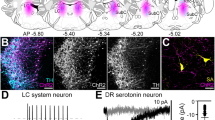Play all audios:

Considerable evidence has accumulated suggesting that purines, adenosine and ATP function as neurotransmitters in the central and peripheral nervous systems1–4. Burnstock2 has proposed that
purinergic receptors be classified into two types, P1 and P2, having adenosine and ATP, respectively, as agonist prototypes. Recent data suggest that ATP may mediate a synaptic potential in
guinea pig vas deferons5,6, but no such evidence exists for adenosine. The presence of a non-cholinergic, non-adrenergic nerve supply to the urinary bladder has been postulated7,8 and termed
purinergic1,2, as these nerves have been shown to release ATP7. Furthermore, atropine-resistant contractions of bladder smooth muscle are thought to be mediated by ATP, while in situ
experiments9,10 in vesical parasympathetic ganglia have suggested that a purinergic modulatory mechanism may control urinary bladder function. We now report the presence of a slow
hyperpolarizing synaptic potential (slow-h.s.p.) in neurones of cat vesical parasympathetic ganglia, produced by stimulating the preganglionic nerves, and provide evidence that the
slow-h.s.p. is mediated by adenosine.
Anyone you share the following link with will be able to read this content:
